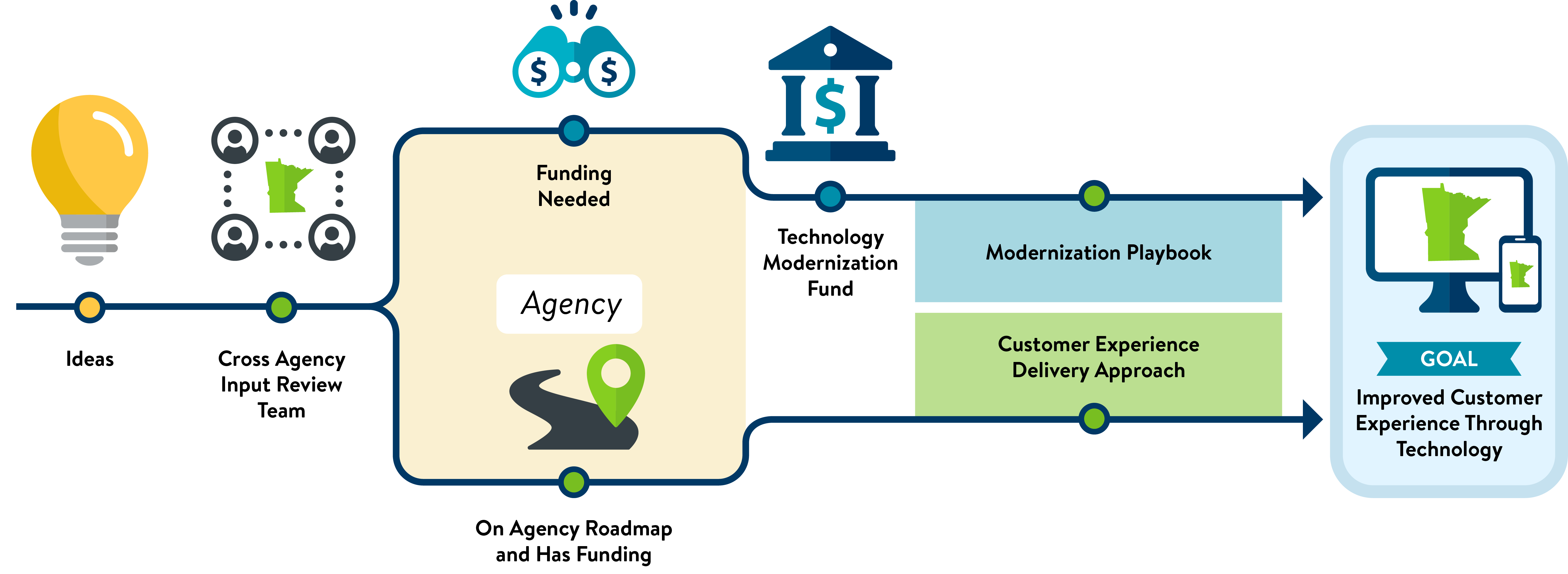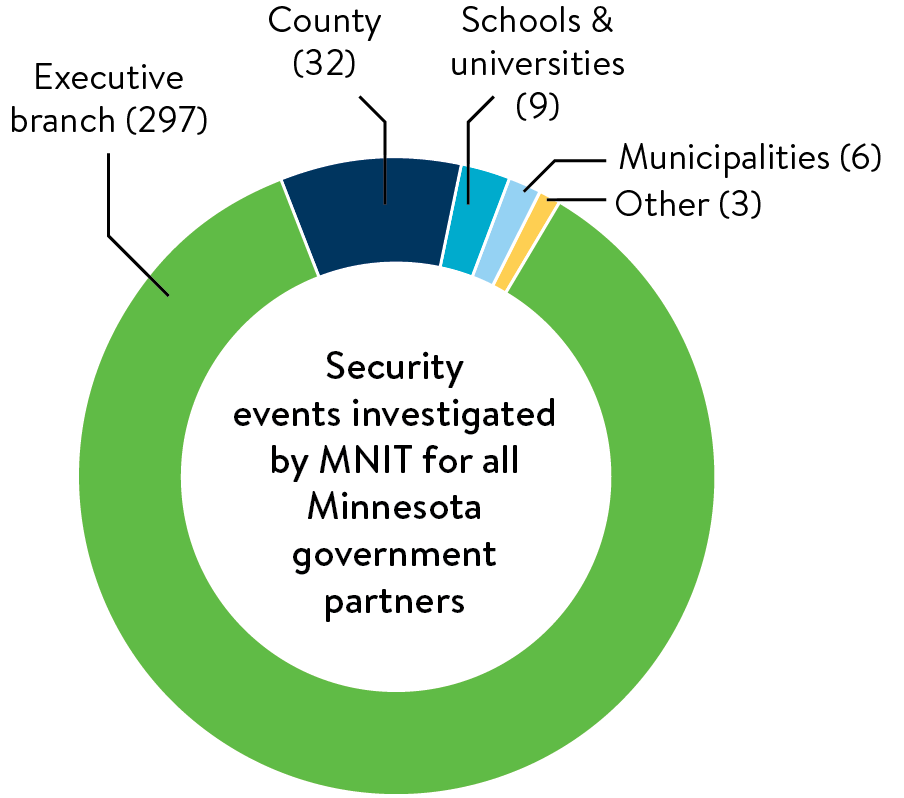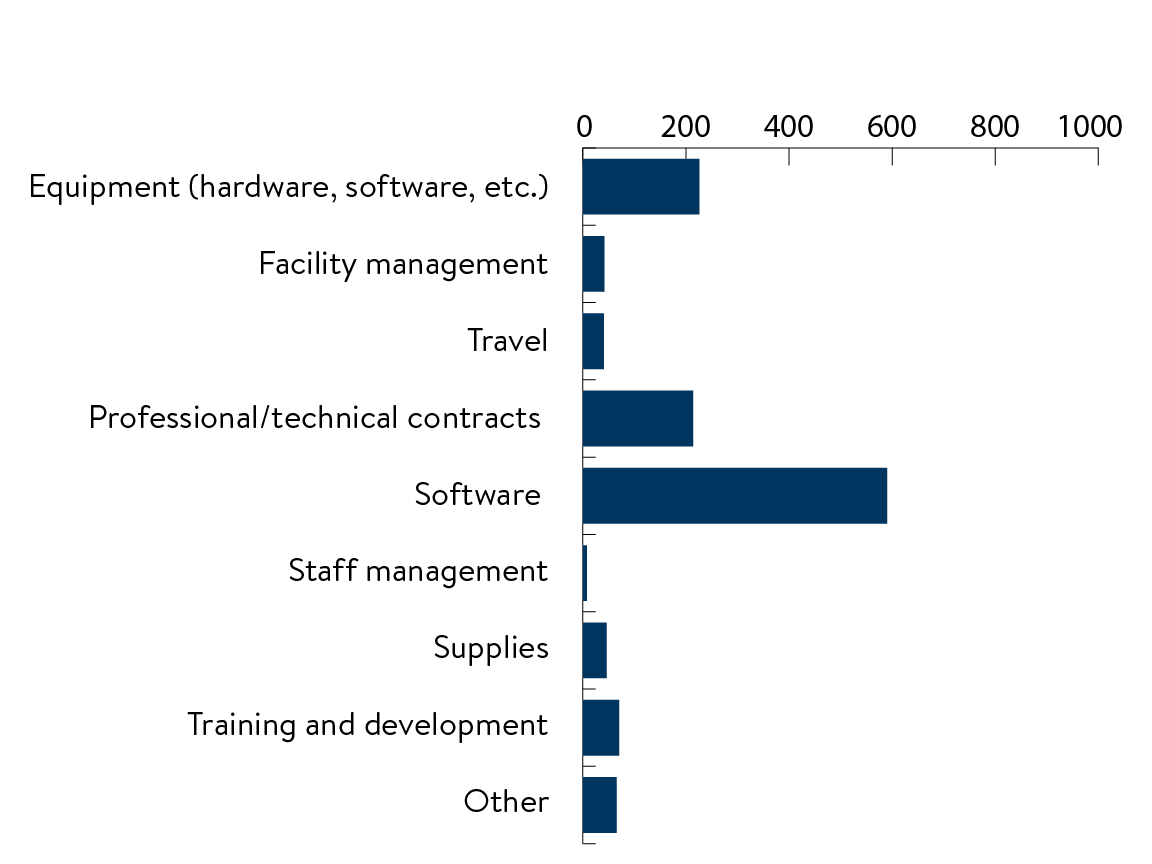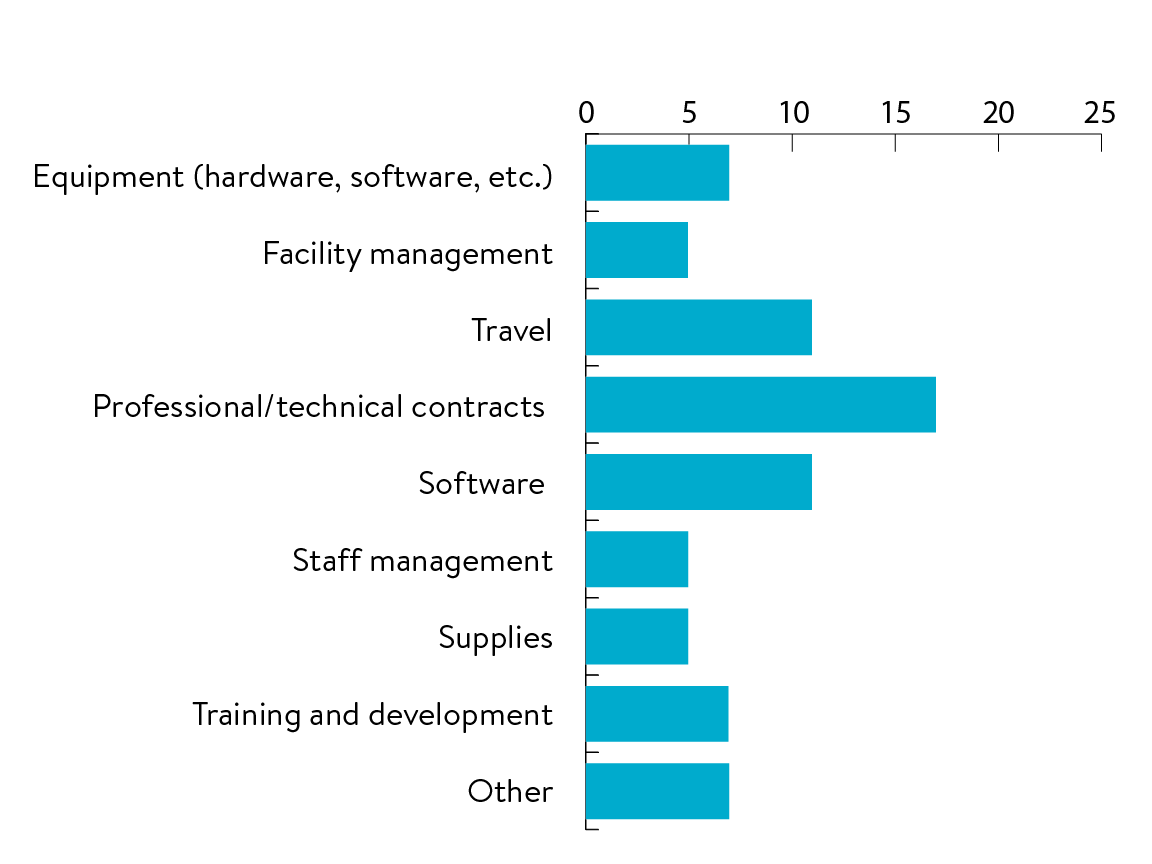



In September, Minnesota IT Services (MNIT), in partnership with the Minnesota Cybersecurity Task Force, launched the 2023 Whole-of-State Cybersecurity Plan to strengthen local government cyber defenses. The whole-of-state approach presents a strong, united front against cybersecurity threats. Additionally, it will be used to distribute $23.5 million of funding from the federal State and Local Cybersecurity Grant Program (SLCGP) and the Minnesota Legislature. At least 80% of funding will go directly to programming that supports local governments, including cities, counties, townships, and schools, and 25% is designated for rural areas where resources are fewer.
The Minnesota Cybersecurity Task Force approved four initial goals in the Whole-of-State Plan. These provide a solid foundation for long-term, sustainable cybersecurity systems that build on results and adjust with the times. MNIT and the task force will continue to engage local government entities, school districts, and Tribal Nations to explain the plan in depth and assess their interest in participating in the plan and SLCGP.
The efforts will:
Minnesotans can find more information about the plan on MNIT’s public site. Eligible entities can learn more by reviewing a participant guide and FAQs or signing up to receive updates.
This past summer Minnesota distributed a one-time tax rebate to households throughout the state. The project required a partnership between the Minnesota Department of Revenue and MNIT to process the safe and secure rebate payments to millions of Minnesotans. Collaborative efforts included the review of more than 3.1 million tax returns to determine eligibility, and then generating the payment files for those eligible. The teams also set up a process to combat fraud and update taxpayer information in a timely manner. In the end, the State of Minnesota delivered more than 2 million tax rebates to Minnesotans.
The goMARTI self-driving shuttle project is the result of a unique partnership of multiple groups, including MnDOT, MNIT, as well as other public and private partners, with a shared goal of increasing accessibility and transportation options for residents and visitors of Grand Rapids and testing self-driving technology in rural, winter conditions. The operation covers nearly 17 square miles and includes over 70 pickup and drop-off points using five autonomous vehicles, including three wheelchair-accessible vehicles.
The free, on-demand rides can be requested through a smartphone app or by calling the local First Call 211 service which helps individuals download and navigate the app and place ride requests. While the vehicles are considered self-driving, there is always an autonomous vehicle operator onboard who verifies the vehicle’s safe operation and aids passengers as needed.
What began as an 18-month demonstration project led by MnDOT, goMARTI recently received federal funding submitted by the Department of Iron Range Resources and Rehabilitation to extend the project at least another three years and expand operations to the neighboring communities of La Prairie and Cohasset. To learn more about the project, go to goMARTI.com.
This collaboration between the MPCA Air Quality Program, MPCA Communications, and MNIT delivered a resilient, accessible system to provide Minnesotans with information they need to help reduce health risks.
The Minnesota Pollution Control Agency (MPCA) publishes current air quality conditions, alerts, and a 3-day forecast generated by a team of meteorologists on its website. Clean air is important to the health of Minnesotans, and when people know the current air quality status, they can make informed decisions and/or take corrective steps to protect their health.
In Fall 2022, MNIT and MPCA started to rebuild the air quality application. The project included redesigned pages, new maps, and a new resilient cloud infrastructure to add features like map accessibility improvements, keyboard navigation, and an alternative screen-readable list view of the data.
Interest in air quality information grows exponentially when poor air quality events occur. A few weeks after the new AQI website went live in May 2023, Minnesota experienced record AQI values due to Canadian wildfires. At peak, the map server received 6 million map image requests in a day. The new system performed well, with zero failed requests and response times staying below 50 milliseconds
MNIT is leading Minnesota’s efforts to elevate customer experience for residents as part of the state’s One Minnesota Plan. In partnership with other state agencies and stakeholders, MNIT launched initiatives to ensure that when Minnesotans engage with state government, they experience modern, user-friendly, secure systems that meet their needs.
This past fall, MNIT hosted a Customer Experience Summit to kick off the One Minnesota Plan focus area. The summit featured remarks by MNIT leadership and the Governor’s Office, and a panel discussion hosted by Technology Advisory Council members.
The event also highlighted details on the formation of the Technology Modernization Fund (TMF) and an idea campaign. Both programs take a people-centered approach to implementing technology solutions to improve the lives of Minnesotans.
As part of the 2023 One Minnesota Budget, the Minnesota Legislature provided $40 million of funding over four years for the TMF. MNIT will use the TMF to resource projects and efforts that modernize, secure, and improve the customer experience of executive branch technology systems.

A Modernization Steering Team (MST), which consists of cross-agency membership, will make recommendations and monitor selected projects. State agencies, boards, councils, and commissions have started submitting funding requests.
Projects under consideration for TMF range from eliminating paper processes for licensures, to updating hard-to-use websites, to enhancing data analytics reporting that will lead to better decision-making outcomes.
Approved efforts will use the Modernization Playbook to simultaneously adopt modern business processes and improve customer and user experiences. While all ideas will be considered, the MST will prioritize submissions that take less than one year to implement, provide substantial business value, and cost less than $1 million.
In September, MNIT launched a campaign to collect ideas from state employees on ways to improve public-facing services through technology. The campaign tapped into the creativity and empathy of the people serving Minnesotans directly. The human-centered discovery work ensures that we meet customers and residents where they are.
State employees submitted more than 300 ideas ranging from the utilization of artificial intelligence to improve processes and services, to enhancing the state’s web presence, to simplifying access to resources and support systems through digital applications.
A cross-agency review team is processing the ideas into themes and identifying action steps to move forward.
To keep state government running and to protect Minnesotans’ private data, we must continually work to better secure Minnesota’s IT systems. Cybersecurity is one of the most critical functions that Minnesota IT Services is tasked with, and it functions best when we are all working together, from the individual citizen to our state agencies, and even to our legislators; that is how we can help protect the 35,000 users of our systems and 5.7 million Minnesotans who have private data secured by the state.
We serve Minnesotans by connecting all 87 counties, 300 cities, and 200 public higher education campuses across the state through MNET – Minnesotan’s dedicated public sector network. This network provides broad visibility into cyber activity occurring across the state. From July through September, our Security Operations Center (SOC) detected or received reports of 347 cyber incidents.

| Type of security incident | # reported |
|---|---|
| Compromised password | 81 |
| Malware | 67 |
| Social engineering | 61 |
| Forensic Investigation | 54 |
| Policy violation | 24 |
| Network attack/scan | 9 |
| Copyright violation | 8 |
| Unauthorized access attempt | 3 |
| Denial of Service | 3 |
| Lost/stolen devices | 3 |
| Multi-factor authentication compromise | 2 |
| Inappropriate use | 1 |
| Other | 31 |
The Procurement Division is responsible for processing all requests to purchase everything from IT hardware, software, and mobile devices to contractors brought in to assist on projects.
Number of Purchase Requests

Average Processing Time (days)

1,280
Purchase Request Volume
11
Average purchase request processing time (days)
The Procurement Division processes requests to purchase everything from IT hardware, software, and mobile devices to contractors brought in to assist on projects and initiatives.
31
Number of projects the office supports and hosts
1,019
Number of resources on the Minnesota Geospatial Commons
47
Orgs sharing their data on the Minnesota Geospatial Commons
+21 Million
Number of hits on the geospatial image server
The Office of Accessibility is charged with overseeing the implementation of accessibility standards for all executive branch employees and state agencies.
1,107
Number of downloads of the Office of Accessibility’s guidance documents
794
Number of downloads of the Office of Accessibility’s quick cards
19
Number of people new people trained in Accessible Word documents
Our enterprise service desk provides 24/7 IT support and services for Minnesota state government: executive branch agencies, boards, councils, and commissions; non-executive branch customers, education, tribal governments, nonprofits; and MNIT staff.
106,791
Total volume of all service desk tickets across the executive branch
48,979
Number of those tickets resolved the same day
45.86%
Percentage of service desk tickets resolved in one day
4.7
Average rating of service desk interaction (1-5 scale)
MNIT staff and our partner agencies are engaged in the final steps to complete service optimization work. This includes transitioning partner agencies to 24/7 IT support from the Enterprise Service Desk and to the Minnesota Service Hub.
Our transitions of the Department of Revenue and the Department of Transportation have been smooth and successful.
“Snow events don’t know they are supposed to have office hours. MnDOT is pleased to gain 24/7 IT Service Delivery for all its shifts. The transition was smooth and seamless. MnDOT gained increased process optimization and improved service.” – Kim Roberson, Interim MNIT CBTO for MnDOT.
“The transition to the Enterprise Service Desk was well executed. Disruptions were minimized through the collaborative communication efforts between MNIT and Revenue on the changes and timelines. A key benefit is the 24/7 MNIT Service Desk support for Revenue staff.” – Cory Stubbendick, MNIT CBTO for the Department of Revenue.
Final transitions are on track for the Department of Education and Professional Educators Licensing Standards Board in late October, and the Department of Health in December.
Minnesota’s technology investment to become faster, more secure, and more reliable continues to move forward. CloudRAMP (Cloud Readiness and Modernization Project) is MNIT’s enterprise project that enables State of Minnesota’s Executive Branch journey to our primary cloud provider Microsoft Azure.
The project has been funded over four years thanks to a $33.595 million investment made by the Minnesota Legislature in 2023 to support the strategy for accelerating our cloud transformation.
This project will impact all executive state agencies through four goals:
Goal 1
To help MNIT to accelerate our progress to migrate server and application workloads, we will contract a migration advisor and moving company. Additional investments include infrastructure, migration tools, and transitional software licenses.
Goal 2
These investments will help MNIT deploy, monitor, and secure the various software development lifecycles of state agency applications and Infrastructure as Code (IaC). This will result in a standardized modern DevOps ecosystem by using contracted vendors to assist with migrating existing DevOps solutions to Azure DevOps Services and GitHub Enterprise.
Goal 3
To be successful in the cloud, we need to provide training and staff development opportunities for staff to learn more based on their role. MNIT will invest in building a learning culture about cloud services.
Goal 4
MNIT will conduct a comprehensive assessment of the current FinOps state. Over time, this will enable us to understand our cloud spend in near real time to manage budgets and make data-informed decisions.
The goals will be implemented in parallel. In Q4, MNIT will begin working with contracted vendors to accelerate Goal 1’s workload migration to Azure agency by agency